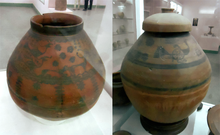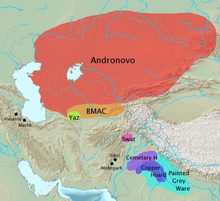Cemetery H culture
"[4] According to Kennedy and Mallory & Adams, the Cemetery H culture also "shows clear biological affinities" with the earlier population of Harappa.[8] According to Kochhar, the Swat IV co-founded the Harappan Cemetery H phase in Punjab (2000–1800 BCE), while the Rigvedic Indo-Aryans of Swat V later absorbed the Cemetery H people and gave rise to the Painted Grey Ware culture (to 1400 BCE).[9] The distinguishing features of this culture include:[10] Some of the designs painted on the Cemetery H funerary urns have been interpreted through the lens of Vedic mythology: For instance, peacocks with hollow bodies and a small human form inside, which has been interpreted as the souls of the dead, and a hound that can be seen as the hound of Yama, the god of death.[12][13] This may indicate the introduction of new religious beliefs during this period, but the archaeological evidence does not support the hypothesis that the Cemetery H people were the destroyers of the Harappan cities.The Rigveda contains a reference to the emerging practice, in RV 10.15.14, where the forefathers "both cremated (agnidagdhá-) and uncremated (ánagnidagdha-)" are invoked.


Rigvedic rivers namesPakistanPunjabHaryanaWestern Uttar PradeshBronze AgeType siteHarappaBhagwanpuracremationPainted Grey Ware cultureIndo-Iranian migrationsAndronovoYaz culturesIndo-IranianCopper HoardIndo-AryanmigrationsHistory of IndiaTimelineMadrasian cultureSoanianBhirranaLahuradewaMehrgarhIndus Valley CivilizationVedic civilizationKuru kingdomEarly Vedic periodRise of Śramaṇa movementLater Vedic PeriodSpread of Jainism – ParshvanathaSpread of Jainism – MahaviraRise of BuddhismBrihadratha DynastyHaryanka DynastyShaishunaga DynastyNanda DynastyMahajanapadasClassicalMaurya DynastyPandya DynastyShunga DynastyKanva DynastySangam periodKushan DynastySatavahana DynastyGupta DynastyEarly medievalPallava dynastyChalukya DynastyHarsha's DynastyKarakota DynastyArab InvasionTripartite StrugglePratihara dynastyRastrakuta DynastyPala DynastyChola Dynasty2nd Chalukya DynastyLate medievalDelhi SultanateMamluk DynastyKhalji DynastyTugluq DynastySayyid DynastyLodhi DynastyPandyan EmpireVijayanagaraBengal SultanateMughal DynastySuri DynastyBengal SubahMaratha EmpireCompany RajKingdom of MysoreSikh EmpireThe Great RebellionBritish Raj Independence MovementIndependent IndiaDominion of IndiaRepublic of IndiaTimeline of Indian HistoryDynasties in Indian HistoryEconomic HistoryLinguistic HistoryArchitectural HistoryArt HistoryLGBT historyLiterary HistoryPhilosophical HistoryMusical HistoryEducation HistoryCoinage HistoryPaper Currency HistoryScience and Technology HistoryList of Inventions and DiscoveriesMilitary HistoryNaval HistoryWars involving IndiaHistory of South AsiaOutlinePalaeolithicSoanian cultureNeolithicBhirrana cultureMehrgarh cultureEdakkal cultureChalcolithicAnarta traditionAhar-Banas culturePandu cultureMalwa cultureJorwe cultureIndus Valley CivilisationVedic CivilisationOchre Coloured Pottery cultureSwat cultureIron AgeJanapadasBlack and Red ware cultureNorthern Black Polished WarePradyota dynastyThree Crowned KingdomsMaha Janapadas